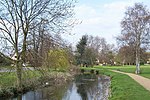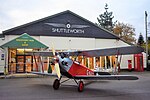Upper Caldecote

Upper Caldecote is a village in the Central Bedfordshire district of Bedfordshire, England about 8 miles (13 km) south-east of Bedford. Its population at the 2011 census was 1,218.It is part of Northill civil parish. Most of Upper Caldecote is situated directly to the west of the A1 road, with facilities including Caldecote CE Academy (a lower school), a post office, Anglican church, Methodist chapel, antiques shop, garage, G&M Growers, cricket club, football pitches and changing rooms, tennis courts, netball court, children's park and two newsagents. The Anglican church of All Saints was built in 1867–8, in yellow brick with red brick banding and dressings, to designs of Arthur Blomfield.
Excerpt from the Wikipedia article Upper Caldecote (License: CC BY-SA 3.0, Authors, Images).Upper Caldecote
Biggleswade Road,
Geographical coordinates (GPS) Address Nearby Places Show on map
Geographical coordinates (GPS)
| Latitude | Longitude |
|---|---|
| N 52.099 ° | E -0.298 ° |
Address
Biggleswade Road
SG18 9BJ
England, United Kingdom
Open on Google Maps








